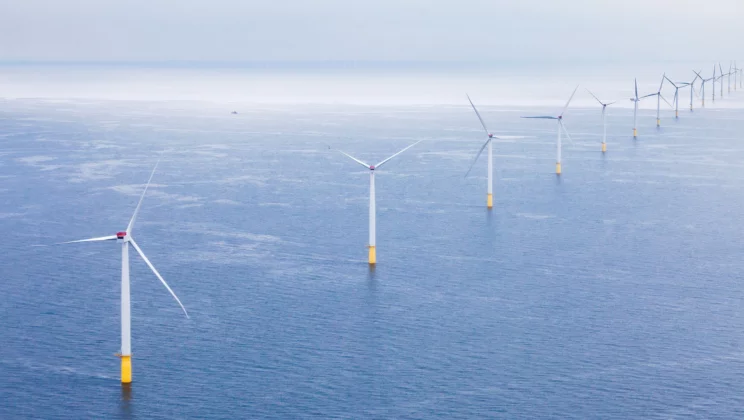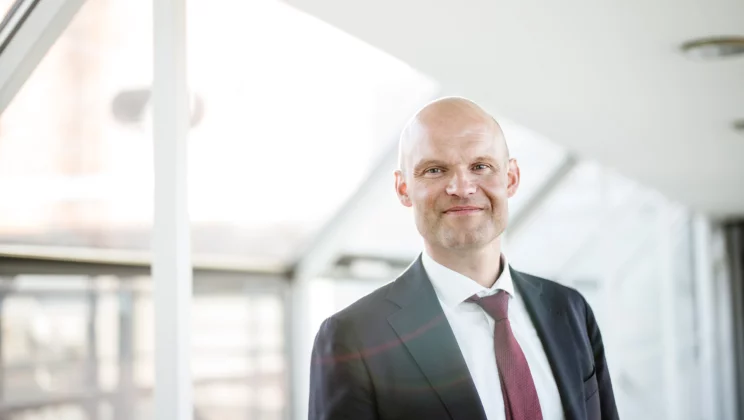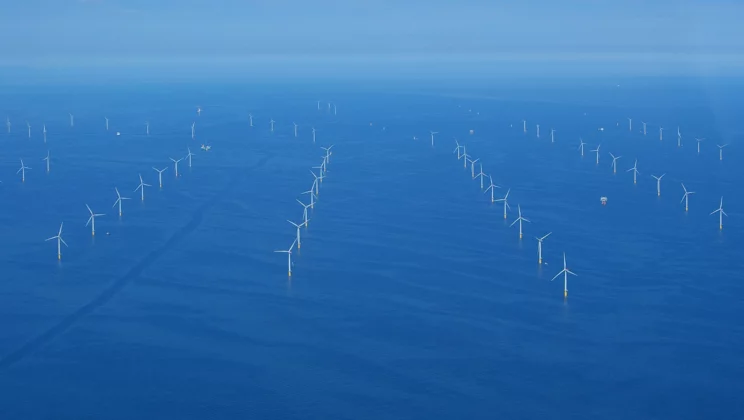Danish pension funds PFA and PKA recently invested DKK 17 billion in Walney Extension, giving them a joint 50 percent stake in the offshore wind farm. A carefully planned strategic initiative, says Henrik Nøhr Poulsen, executive director and chief investment officer, Equities & Alternatives at PFA, about the pension fund’s first ever offshore wind investment. He also announced that PFA is prepared to commit to more offshore wind investments provided the balance between risk and return is right. To strike the right balance – also in the future – better battery technology will be key.
While 2017 started off with the news that low returns were deterring pension funds from offshore wind, prospects seemed much more positive towards the end of the year.
The announcement by PFA and PKA in early November of a DKK 17 billion investment in the Walney Extension offshore wind farm, which is currently under construction by Ørsted off the coast of Cumbria in the Irish Sea, certainly put paid to the notion that pension funds are not looking at offshore wind opportunities. When completed in 2018, Walney Extension will be the world’s largest wind farm with the capacity to power 500,000 homes.
For PFA, this investment has been a long time coming and is part of a major strategic restructuring of the pension fund, says Chief Investment Officer of Equities & Alternatives at PFA Henrik Nøhr Poulsen.
“We no longer find that listed markets alone generate the return we are looking for. Consequently, we are engaged in diversifying and seeking out new sources of return,” he says and elaborates:
“Basically, we need to secure investments with a long-term stable return, and, in our assessment, the risk we have assumed with Walney Extension is commensurate with the expected return.”
Danish far-offshore wind turbines provide security
Walney Extension will comprise 40 turbines supplied by MHI Vestas and 47 turbines supplied by Siemens Gamesa, with a capacity of 8 MW and 7 MW, respectively. According to Henrik Nøhr Poulsen, the fact that the turbines for Walney Extension are being supplied by two industry heavyweights has been an important factor in the investment decision.
“As suppliers, they are guarantors of the level of quality that is crucial for us as investors to feel comfortable about investing,” he explains.
Parts of the turbines have been shipped from Esbjerg, which has been used by both MHI Vestas and Siemens Gamesa for shipping turbines to a number of wind farms in Northern Europe over the seventeen years. Although the turbine type of the Walney Wind Farm is new, it has been developed on the basis of years of experience in the two companies. To Henrik Nøhr Poulsen and his staff, this provides peace of mind, he says.
This is also why he believes that although more players are entering the wind market, the Danish wind industry is poised to keep its lead.
“As wind farms are moving further and further offshore, solid, reliable solutions that will be dependable for many years are crucial in reducing our risk as investors,” he says and elaborates:
“In terms of offshore wind in particular, the Danish wind industry enjoys a unique competitive edge thanks to the expertise we have acquired in this area. Durability and reliability requirements are much more stringent offshore than onshore, and in this area we are geared to manufacturing turbines that guarantee operations for many years to come.”

Walney Extension will comprise 40 turbines supplied by MHI Vestas and 47 turbines supplied by Siemens Gamesa, with a capacity of 8 MW and 7 MW, respectively.
New strategy and new staff are paving the way
When we get through to Henrik Nøhr Poulsen on the telephone, he has just landed in Denmark after a visit to Harvard Business School. He had been invited to give a talk on PFA’s approach to alternative investments – an initiative he has been spearheading since 2015 when the Board of Directors adopted its new 2020 strategy plan focusing on promoting private equity investments.
Two years later, on 1 November 2017, Henrik Nøhr Poulsen announced PFA’s first ever offshore wind investment. In the meantime, he had been focusing intently on putting together the right team for this task. Investment in infrastructure such as offshore wind is different from traditional listed investment and requires a different skills set.
“We knew from the start that, to bring our initiative to fruition, we needed a new department with staff specialising in this type of investment. That is why we have focused on building those skills in-house,” says Henrik Nøhr Poulsen.
The new department currently has 13 staff, eight of whom make investments and five provide support, for instance in risk assessment and management.
“The aim has been to enable us to make large-scale private equity investments, for instance in infrastructure and energy. These efforts are paying off with the investment in Walney Extension,” says Henrik Nøhr Poulsen.

Henrik Nøhr Poulsen has headed PFA’s approach to alternative investments since 2015.
New winds are blowing in the market
It has taken more than a year to complete the Walney Extension investment. Henrik Nøhr Poulsen will not rule out the possibility that PFA may add a further offshore wind investment or two to their investment portfolio over the coming years. But the trade-off between risk and return is always at the heart of the approach taken by Nøhr Poulsen and his team.
“A number of UK and German offshore wind projects will be launched in the coming years, but the risk will become higher and competition stronger. The special feature of Walney Extension is that it is one of the last projects to be negotiated with a type of subsidy that ensures our return,” he explains.
For Walney Extension, the fixed-price agreement is £150/MWh for 15 years. Today, such agreements are becoming increasingly rare.
Most recently, Kriegers Flak set a new electricity price record when Vattenfall won the contract with DKK 0.372/kWh. In Germany, in April, Ørsted won the contract to build three new wind farms in the German sector of the North Sea, two of which are to be built without any fixed-price agreement with the German government. According to Henrik Nøhr Poulsen, projects are also moving further and further offshore. That makes installation and construction more complex and the risk assumed by investors higher.
“I am sure there will be more opportunities for us in the future, but we are aware of ongoing developments that, all else being equal, will have to be reflected in our risk assessment.”
Better battery technology is key to the future
In the long term, unsubsidised offshore wind farms will not deter PFA from making offshore wind investments. In Henrik Nøhr Poulsen’s opinion, the abolition of subsidies indicates that offshore wind is becoming increasingly competitive compared to conventionally generated electricity, which is positive.
“When Ørsted bids for completely unsubsidised projects, this reflects the fact that they believe in further efficiency enhancement of turbines. The performance of the turbines will improve while the cost of generation will decrease,” says Henrik Nøhr Poulsen, predicting that this development will also create a political tailwind for more offshore wind turbine projects.
Asked whether unsubsidised wind farms deter pension funds from investing, Henrik Nøhr Poulsen shakes his head.
“Unsubsidised wind farms are the future. It may take four years or eight years, but we will get there. We won’t be investing in an unsubsidised wind farm next year, but as experience in building and running large wind farms increases, it’s by no means unlikely that we’ll be looking at unsubsidised wind farms in the future,” he says, stressing in the same breath the key parameter for future investments which is battery technology:
“Our decision about whether to invest in unsubsidised offshore wind in the future hinges on the development of better battery technology. If power storage opportunities improve, the risk declines substantially which will obviously make things very, very interesting for us.”

Better battery technology is key to future investments in wind energy, says henrik Nøhr Poulsen. If power storage opportunities improve, the risk for investors declines substantially.
Go to overview

